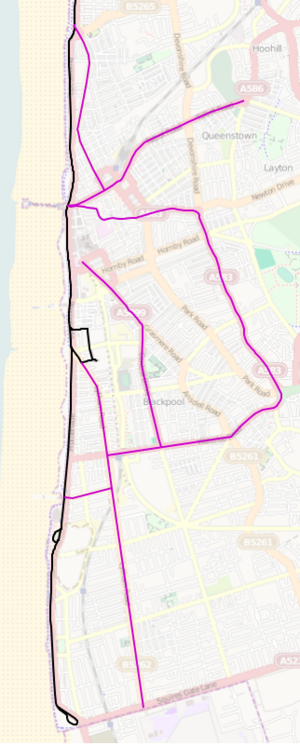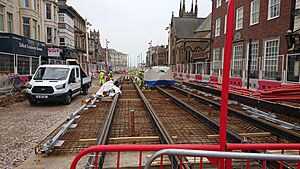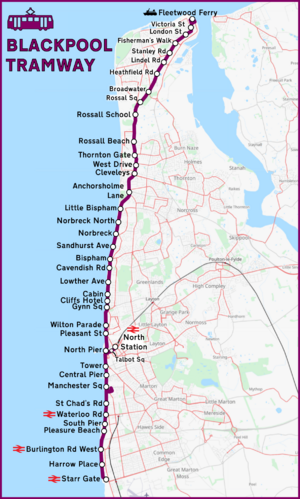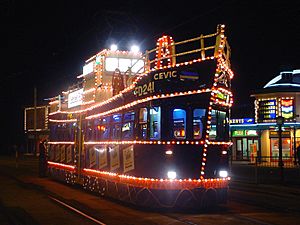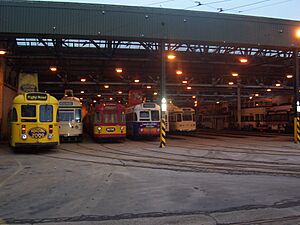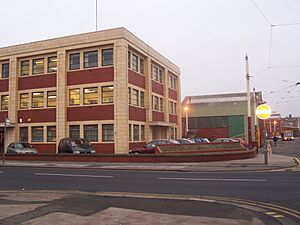Blackpool Tramway facts for kids
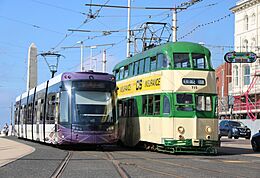
A Bombardier Flexity 2 and a Balloon double-decker at North Pier
|
|
| Operation | |
|---|---|
| Locale | Blackpool, Fleetwood, and the Fylde Coast, England |
| Open | 29 September 1885 |
| Status | Open |
| Lines | 3 |
| Routes | |
| Owner(s) | Blackpool Council |
| Operator(s) | Blackpool Transport |
| Infrastructure | |
| Track gauge | 1,435 mm (4 ft 8 1⁄2 in) standard gauge |
| Electrification | 600 V DC Overhead lines |
| Stock |
|
| Statistics | |
| Route length | 18 km (11.2 mi) |
| Stops | 40 |
| Passengers (2023/24) | 4.7 million |
The Blackpool Tramway is a historic tram line in Lancashire, England. It connects the towns of Blackpool and Fleetwood along The Fylde coast. This tramway first opened in 1885, making it one of the oldest electric tram systems in the world.
Blackpool Transport Services (BTS) operates the tramway. The line stretches for about 18 kilometers (11 miles). In the 2023/24 year, it carried 4.7 million passengers.
It is the second-oldest electric tramway in the United Kingdom. The Volk's Electric Railway in Brighton opened a couple of years earlier. Both tramways run on special tracks along the seafront. The Blackpool Tramway is one of the few places in the world that still uses double-deck trams. Other places include Hong Kong and Alexandria, Egypt. Since 2012, most services use modern Bombardier Flexity 2 trams. However, a special 'heritage service' uses older, traditional trams. This service runs on weekends, some weekdays, and during the famous Blackpool Illuminations.
Exploring the History of Blackpool Trams
Early Days and Growth (1885–1910s)
The first part of the tramway opened on September 29, 1885. It was a special type of line where electricity came from a channel under the tracks. This was a very early example of electric trams. The system was invented by Michael Holroyd Smith.
The Blackpool Electric Tramway Company ran the trams until 1892. Then, Blackpool Corporation took over. More lines were added, connecting different parts of Blackpool. However, the original underground electricity system had problems. Seawater and sand from the coast often got into the channels. This caused electrical issues and made the system unreliable.
In 1899, the tramway switched to a more modern system. They installed overhead wires that supplied 550 volts of electricity. This solved many of the old problems. The tram lines continued to grow, reaching Gynn Square in 1900 and the Blackpool Pleasure Beach by 1903.
Expanding and Changing Routes (1920s–1960s)
In 1920, Blackpool Corporation took over the Blackpool and Fleetwood Tramroad. This added 8 miles of track and 41 more trams to their network. A new, larger depot was built at Rigby Road in 1920, and another in 1935.
The tramway expanded further in 1926, reaching Starr Gate. This was the last major extension. In the 1930s, new, modern trams were introduced. These included sleek Railcoaches and the famous double-deck 'Balloons'. These trams became a key part of the fleet for many years.
However, some routes began to close in the 1930s. More closures happened in the 1960s, leaving only the main line from Starr Gate to Fleetwood. This is the route that still operates today. In 1986, Blackpool Transport Services Limited took over running the trams and buses.
Blackpool was unique because it kept its trams when many other UK towns removed theirs. Between 1962 and 1992, it was the only urban tramway left in the UK.
Challenges and Modernization (1970s–2007)
During the 1970s, the tramway faced financial difficulties. To save money, they developed trams that could be operated by just one person. They also started using all-over advertisements on trams to earn more income. This idea of advertising on trams had been around since the early days, but full-body adverts became popular in 1975.
In the early 2000s, there were plans to expand the tram network. Blackpool Council and Lancashire County Council tried to get government funding for this. However, these expansion plans did not move forward at that time.
In November 2007, the entire tramway closed for five months for important repair work. During this time, a new prototype tram called the City Class 611 was being tested. In January 2007, this tram caught fire near Central Pier, causing significant damage. The driver safely exited the tram. The tram was rebuilt but was not allowed to continue trials in Blackpool. It was later planned to be used for a trial park and ride tram line in Preston.
Major Upgrade and New Trams (2012)
In February 2008, the government agreed to provide funding for a complete upgrade of the tramway. This project cost £85.3 million. The government contributed £60.3 million, with Blackpool Council and Lancashire County Council providing the rest.
This funding allowed for the entire track to be upgraded. Also, 16 new Bombardier Flexity 2 trams were ordered to replace the older fleet. The upgrade work meant that some parts of the tramway were closed between 2009 and 2012. Replacement bus services helped passengers during this time.
In 2011, the electricity supply for the line was increased to 600 volts. The traditional trams ran their last regular service on November 6, 2011. The upgraded tramway reopened on April 4, 2012. The new Flexity 2 trams now handle the daily services. Some traditional trams were kept and restored. These form the 'Heritage Fleet' and are stored at Rigby Road Depot. The new Flexity 2 trams are kept at the modern Starr Gate Depot.
Blackpool North Station Extension (2024)
An exciting extension of the tramway opened on June 12, 2024. This new line runs along Talbot Road to Blackpool North railway station. It connects to the Promenade line at Talbot Square. This extension added a new route, allowing trams to travel from the existing termini directly to the station.
Work for this extension began in November 2017. A homeware store was demolished in September 2020 to make space for the new tram terminal. Testing of the new line started in March 2022. The project included a new tram terminal and an underpass for easy access to the railway station.
Heritage Fleet Temporarily Suspended (2024)
In December 2024, the special heritage tram service was temporarily stopped. Blackpool Transport Services explained that this was due to challenges like limited depot space and difficulties with tram movements and maintenance. However, the management confirmed that this is a temporary measure. They expect the heritage service to return sometime in 2025.
Blackpool Tramway Network Today
Tram Routes and Stops
The tramway runs from Starr Gate in Blackpool to the Ferry Terminus in Fleetwood. Most of the route follows the beautiful Fylde Coast seafront. It turns inland at Cleveleys before reaching Fleetwood. There is also a branch line in Blackpool Town Centre that goes to Blackpool North Railway Station.
During busy times, like the Blackpool Illuminations, some trams might end their journey earlier. This helps to provide more frequent services in the central Blackpool area. During the Illuminations, special decorated trams carry passengers along the illuminated promenade. Trams usually run every 10 minutes during the day.
There are four turning loops along the line. These are at Starr Gate, near the Pleasure Beach, Little Bispham, and Fleetwood. There are also connections to the Rigby Road Depot.
Trams in Service
The modern Bombardier Flexity 2 trams operate most of the main services. Some modified English Electric Balloon double-deck trams are also available if needed.
A 'heritage service' uses older, traditional trams. This service usually runs on certain weekdays, weekends, and during the summer months. It also offers tours during the Illuminations. This service was temporarily suspended in December 2024 but is expected to return in 2025. Heritage trams stop at special 'heritage stops' located near the regular tram stops.
Fleetwood Transport Festival
Every year, the Fleetwood Transport Festival, also known as Tram Sunday, takes place on the third Sunday in July. This popular event attracts thousands of visitors. It fills the entire main street, Lord Street, with displays. Visitors can enjoy vintage tram rides from Fishermans Walk to Thornton Gate.
Blackpool Tram Fleet
Current Trams in Use
As of July 2021, the Blackpool Tramway uses the following main trams:
| Class | Image | Type | Top speed | Length (metres) |
Capacity | In service |
Fleet numbers |
Routes operated |
Built | Years operated |
|||
|---|---|---|---|---|---|---|---|---|---|---|---|---|---|
| mph | km/h | Std | Sdg | Total | |||||||||
| Bombardier Flexity 2 |  |
Tram A fleet |
43 | 70 | 32.23 | 74 | 148 | 222 | 16 | 001-016 | All | 2010–2012 | 2012–present |
| 2 | 017-018 | 2016–2017 | 2018–present | ||||||||||
| English Electric Balloon (modified) |
 |
Tram B fleet |
Varies | 6 | 700, 707, 711, 718 | All + Heritage | 1934–1935 (refurbished 2009–2012) |
1934–present | |||||
| Total | 24 | ||||||||||||
The tram fleet is divided into three groups. The 'A' fleet consists of 18 Flexity 2 trams. These are fully accessible for everyone. The 'B' fleet includes six modified double-deck trams. These have some accessibility improvements. The 'C' fleet is the special heritage fleet, which is exempt from some accessibility rules. The heritage fleet was temporarily suspended in December 2024.
The main fleet trams have a distinctive look. They feature purple fronts, white sides, and black window frames. There's also a purple criss-cross pattern on the lower sides. Some modified Balloon trams also wear this purple design.
Bombardier Flexity 2 Trams
As part of the tramway upgrade, 16 Bombardier Flexity 2 trams were ordered. These trams are numbered 001 to 016. The first new tram was shown to the world on September 8, 2011, at the new Starr Gate depot.
These modern trams offer many benefits. They have step-free access from the platform, making them easy for everyone to board. They also have special spaces for wheelchairs. They can carry more passengers, accelerate faster, and run more quietly. Inside, they have screens that show the 'next stop' information.
Two more Flexity 2 trams, numbered 017 and 018, arrived in December 2017. They were ordered to help with the increased demand when the extension to Blackpool North railway station opened. These two trams started service in March 2018. All Flexity 2 trams are kept at the Starr Gate depot.
Modified 'Balloon' Double-Deck Trams
Nine of the classic Balloon trams were updated between 2009 and 2012. These trams, numbered 700, 707, 709, 711, 713, 718, 719, 720, and 724, had their door areas widened. This change made them compatible with the new tram stop platforms. They can be used for both regular services and as extra trams for the heritage service. Currently, six of these modified trams are believed to be ready for operation.
Blackpool Heritage Trams
Blackpool has a rich history of trams. A large collection of old trams from Blackpool's past, and some from other places, are part of the Blackpool Heritage Tram Tours. This special fleet was temporarily suspended in December 2024. However, it is expected to resume operations sometime in 2025.
Most heritage trams wear the traditional green and cream colors of Blackpool Transport. These styles come from different periods between the 1930s and 1990s. Some trams have red and cream/white colors or other unique designs. A few trams also feature colorful all-over advertisements.
Tramway Infrastructure
Types of Track
The tram route uses different kinds of tracks:
- Street running: These tracks are on regular roads and shared with other traffic. You can find them on Lord Street and North Albert Street in Fleetwood, and on Talbot Road in Blackpool town centre. There's also a short section near Rigby Road Depot used only by trams entering or leaving service.
- Paved reserved track: These tracks run alongside a road. Pedestrians can walk on them, but cars cannot. Most of the route between Starr Gate and Cabin uses this type of track.
- Reserved ballasted track: These tracks are only for trams. They are separate from roads and pedestrians. You can see this type from Cabin to Rossall and on Radcliffe Road in Fleetwood.
- Interurban style: These tracks do not follow a road and are exclusively for trams. This section runs from Rossall to Radcliffe Road in Fleetwood.
Power Supply for Trams
The trams get their power from a 600-volt DC overhead line. Electricity is sent to the trams using a pantograph (a device on the roof). A few older, vintage trams use a trolley pole instead.
Tram Depots
Blackpool Tramway has two active depots:
- Rigby Road Depot: This depot was built in 1935 and is still in use today. It can hold up to 108 trams. It has been updated several times over the years. This depot is now home to the traditional heritage trams.
- Starr Gate Depot: Built in 2011, this modern depot cost £20 million. It opened in Easter 2012 and can hold up to 20 articulated trams. It was built specifically for the new Flexity 2 trams.
Former Depots
Five other depots have closed over the years:
- Bispham Depot: Opened in 1898, it closed in 1963 and was later demolished.
- Bold Street Depot: Opened in 1899, it was a small depot that closed in 1920.
- Blundell Street Depot: The first depot, opened in 1885, it was demolished in 1982.
- Copse Road Depot: Built in 1897, it closed in 1963 and was demolished in 2016.
- Marton Depot: Built in 1901, it closed in 1963. Part of it was demolished, and a petrol station now stands on the site.
Tickets and Fares
You can buy tickets from the conductor on board the tram. Daily, three-day, seven-day, and monthly 'saver' tickets are also available. These tickets can be used on regular trams (not heritage trams) and Blackpool Transport buses.
Special heritage tram tickets are available for round trips between Pleasure Beach and Cabin. Group day tickets are also offered for up to 5 passengers, including adults, children, and dogs. Heritage day tickets can also be used on all Blackpool Transport trams and buses, as well as for autumn illumination tours.
If you have a National Rail ticket to Blackpool stations with a Plusbus add-on, it includes unlimited tram travel between Thornton Gate and Starr Gate.
How Blackpool Tramway is Managed
Ownership and Operation
The Blackpool Tramway is operated by Blackpool Transport Services Limited (BTS). This company manages public transport services, including buses and trams, along the Fylde coast. BTS is fully owned by Blackpool Council. The Council leases the tramway and its buildings to BTS.
Tramway Performance
While full financial details for the tramway are not published separately, we know that passenger numbers and revenue change over time. For example, in the financial year 2020/21, tram services were greatly affected by the coronavirus pandemic. The UK government provided a grant to cover the lost income during this challenging period.
Future Plans for the Tramway
There are ideas for extending the tramway further. Some proposals include extending lines to Lytham St Annes and Poulton-le-Fylde. Blackpool Council, Fylde Council, and Wyre Council have applied for funding to study a "Tram Loop" idea. This loop would connect these branch lines.
Images for kids
-
Brush Railcoach No. 623 in Mystique show advert livery
See also
- List of Blackpool Tramway tram stops
- Light Rail Transit Association
- List of modern tramway and light rail systems in the United Kingdom
- List of town tramway systems in the United Kingdom
- Public transport in the Fylde
- Maley & Taunton
- Scottish Tramway and Transport Society
- Trams in Europe


